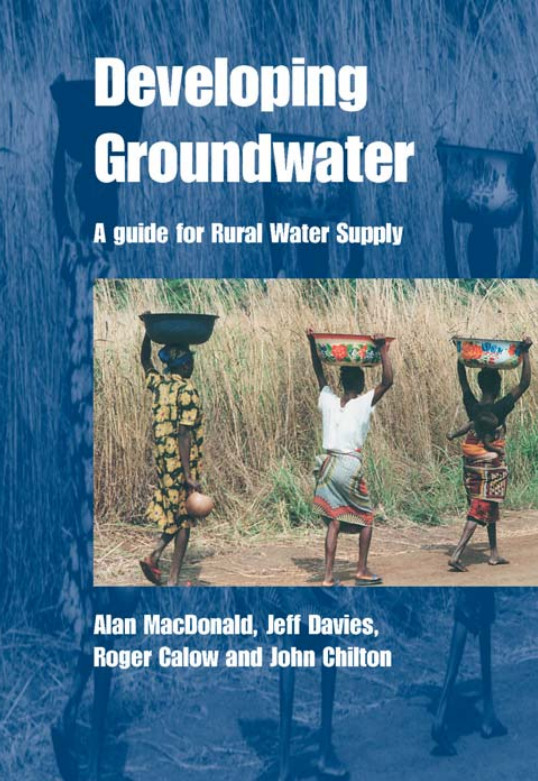Developing Groundwater: A guide for rural water supply
 |
manuel Jan 2005 ; 358 pages
Aut. Roger Calow & John Chilton & Alan MacDonald &
Ed. Practical Action - Rugby ; Isbn: 978-1-85339-596-3
Téléchargeable sous format: PdF
Téléchargeable chez l'éditeur
Page de présentation d'un éditeur
 Pourquoi certains forages sont-il meilleurs que d'autres?
Abstract:
Pourquoi certains forages sont-il meilleurs que d'autres?
Abstract:In many rural areas, groundwater is the only feasible way of providing safe, reliable water supplies. However, developing groundwater is not always straightforward. To meet the targets set out in the Millennium Development Goals, more attention needs to be paid to finding and developing groundwater in a sustainable, cost-effective and participatory manner. Developing Groundwater provides a user-friendly guide to this key topic, bringing together for the first time the wide range of techniques required to develop groundwater for community water supplies. This practical manual gives information on effective techniques for siting wells and boreholes, assessing the sustainability of sources, constructing and testing the yield of boreholes and wells, and monitoring groundwater quality. The authors set the technical aspects of rural water supply firmly in their socio-economic context, so that readers can take proper account of community concerns as well as purely engineering questions. Packed with helpful illustrations this book is indispensable for all rural water supply project staff in developing countries.
Developing groundwater, an output from DFID’s Engineering Knowledge and ResearchProgramme, adds valuable and practical information and techniques to the existingknowledge base for implementing rural water supply projects in sub-Saharan Africaand Asia.
The manual is unique in that it has been developed in consultation withpeople from 29 countries who helped to design the structure and scope of thecontents. It contains information to improve our understanding of groundwaterresources, on techniques to locate and construct water points, and to appreciatewater quality issues, together with ideas on community management and resource requirements. Contents:
1The need for a manual1
1.1Who is the manual for?2
1.2The scope of the manual3
1.3The contents of the manual: a roadmap4
1.4Don’t panic, you are not alone5
1.5Groundwater7
2Groundwater – a mysterious resource7
2.1Groundwater in the hydrological cycle8
2.2Groundwater: basics and definitions9
2.3Different hydrogeological environments13
2.4Accessing groundwater24
2.5Projects and communities31
3Introduction31
3.1Basic principles and concepts in rural water supply32
3.2Project–community interaction in the project cycle41
3.3Developing a project strategy56
3.4Summary: key messages for the project manager72
3.5Reconnaissance77
4Why is reconnaissance important?77
4.1Checklist for useful information78
4.2Tapping into existing knowledge82
4.3A reconnaissance site visit83
4.4Filling in the gaps88
4.5Making use of the information: creating a conceptual model89
4.6Finding groundwater96
5Introduction96
5.1Choosing a siting technique97
5.2vCopyright practicalactionpublishing.com
Village observations and discussions111
5.3General principles for surveys118
5.4Resistivity123
5.5Electromagnetic methods – FEM134
5.6Magnetic methods146
5.7Designing and constructing water points153
6Introduction153
6.1Drilling methods153
6.2Roles and responsibilities165
6.3Collecting data during drilling169
6.4Borehole design and construction178
6.5Reporting196
6.6Springs197
6.7Large-diameter wells203
6.8Assessing the yield of a source209
7Why carry out pumping tests?209
7.1Pumping test basics211
7.2Measuring yield during an airlift217
7.3The bailer test218
7.4Constant-rate tests225
7.5Analysing constant-rate tests230
7.6Large-diameter wells238
7.7Water quality aspects of rural water supply241
8Quality of water for drinking –‘safe’ water supplies241
8.1Drinking-water guidelines and standards242
8.2Microbiological quality of groundwater supplies245
8.3Chemical quality constraints on water supply260
8.4Assessing the potential for chemical pollution of groundwater282
8.5Monitoring groundwater quality in rural supplies287
8.6Learning lessons292
9Why lesson-learning is important292
9.1The uses and users of project data292
9.2Storing useful information – a project perspective294
9.3Making use of information295
9.4Appendix 1 Identifying different rocks301Getting samples301
A1.1The tools of the trade302
A1.2Describing and recognizing rocks302
A1.3Igneous rocks308A1.4Sediments and sedimentary rocks310
A1.5Metamorphic rocks310
A1.6Appendix 2 Data forms333
Mots clefs: |
Editeur/Diffuseur: |
|
Practical Action - Rugby - Royaume Uni |
En cas de lien brisé, nous le mentionner à communication@pseau.org